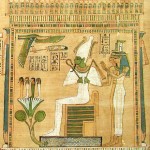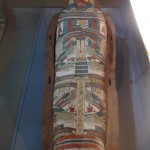
The Egyptian Collection of the Archaeological Museum of Zagreb and its Mummies
The Egyptian collection in the Archaeological museum in Zagreb currently has over 2,300 artifacts of Ancient Egypt, and is the largest and most complete collection of its kind in Croatia. The first acquisition, the Zagreb mummy, is still its most famous artifact today. It came to the museum in 1862, and remains the core of the collection. Another part of the collection was bought from a famous Roman junkman in Naples called Lancia (Tomorad 2003). Studies revealed that most items came from Luxor and the surrounding areas. [more…]
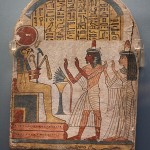
A Context for Nehmes-Bastet (KV64): A Birds Eye View of the Early Third Intermediate Period – Part 1
In January 2012, thanks to the discovery of a new tomb in the Valley of the Kings, named KV64, the 22nd Dynasty was catapulted into the spotlight. At the moment, apart from a couple of tantalising photographs and a video released by the University of Basel (Switzerland) all we know is that the mummified woman was called Nehmes-Bastet; she was a chantress; and her father was a priest at the Temple of Karnak [more…]
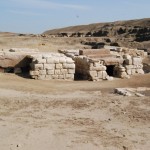
A Context for Nehmes-Bastet (KV64): A Birds Eye View of the Early Third Intermediate Period – Part 2
In Part 1 the political background to and development of the Third Intermediate Period was described, emphasizing the way in which power became divided, both within the Delta and between the Delta and the south, where the Theban high priests became increasingly powerful. Part 2 looks at the blending of Libyan and Egyptian traditions, with new ideas expressed in funerary practices and in the role of religious institutions. [more…]
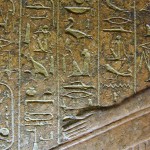
Lecture Review: The re-excavation of the tomb of Horemheb in the Valley of the Kings by Professor Geoffrey Martin
Professor Martin is currently engaged in assembling the results of his work re-excavating the tomb of Horemheb for publication, and it became clear from his lecture that this work is long overdue and will be welcomed by the academic community. Martin described re-excavation as a new type of archaeology, geared specifically to finding information that previous excavators may have missed. He cited Kemp’s work at Amarna as an example of this. [more…]
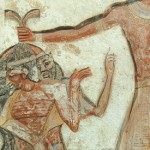
Book Review: Judgement of the Pharaoh
In Judgement of the Pharaohs Tyldesley has tackled a subject that challenges the populist view of Ancient Egypt as a perfect world untroubled by social problems. Tyldesley begins by explaining how she described the idea for her new book to a colleague who said “Crime and punishment in ancient Egypt – surely there wasn’t any?” If an archaeological colleague was so quick to question that perfection of the Egyptian idyll, it is just as well that Tyldesley begins by assuring the reader that there was plenty of crime to be punished. [more…]
Comparison of the stelae of wsrimn (Fisher Collection, Detroit) and of ddwsbk (Louvre C240 and BM566) of Dynasty XII
Abstract
The 12th Dynasty (Middle Egytian) judicial system was surprisingly modern in its approach and composition, but our knowledge is assembled by a process of deduction. Most of the key evidentiary sources are testimonial stelae which list the titles held by senior officials during their lifetimes. The nature of an individual’s role in the judicial process can be postulated from the combination of titles held, in turn allowing a picture of the overall operation of kingly justice to emerge. “The paper considers the titles and history of two such individuals, comparing and contrasting the titles they held to build a picture which reveals the existence of investigative judicial processes. [more…]
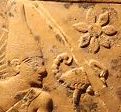
Who Is King Scorpion?
Abstract
The ‘Scorpion’ Mace-head is one of the most significant objects from the main deposit at Hierakonpolis. Unlike the Narmer Mace-head, it is not a complete mace-head but only part of one. Apart from the dominant figure after whom the palette is named, the surrounding scenes are partial; however excellently these have been conserved. This makes the object even more enigmatic and difficult to interpret than usual in the context of the development of Early Dynastic royal iconography. [more…]
This article re-examines the evidence and suggests an alternative identification for King Scorpion. [more…]
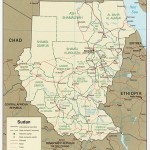
The contributions of A.J. Arkell to eastern Saharan prehistory
Abstract
Anthony John Arkell (1898 – 1979) was a pioneer of Sudanese archaeology, a precise and conscientious surveyor and excavator whose publications are still invaluable today. His work provided the framework within which conversations about the prehistory of the Sudan are discussed. When he returned to live and work in England Arkell was responsible for restoring the collections of the Petrie Museum of Egyptian Archaeology, its contents having been packed into 800 boxes during the Second World War. He went on to research and write about the Egyptian Predynastic, helping to revive interest in the pre-Pharaonic period. Anthony Arkell’s contribution to the archaeology of the Eastern Sahara is explored with reference to both his own publications and to comments made by other researchers about the range and value of his work. [more…]
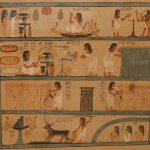
 By
By 